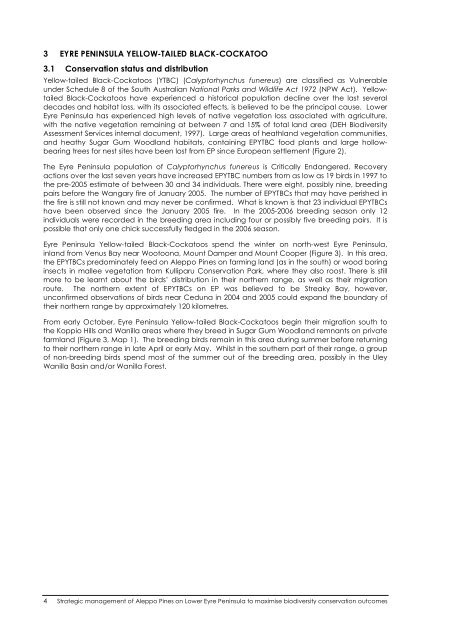Strategic management of Aleppo Pines on Lower Eyre
Strategic management of Aleppo Pines on Lower Eyre
Strategic management of Aleppo Pines on Lower Eyre
Create successful ePaper yourself
Turn your PDF publications into a flip-book with our unique Google optimized e-Paper software.
3 EYRE PENINSULA YELLOW-TAILED BLACK-COCKATOO<br />
3.1 C<strong>on</strong>servati<strong>on</strong> status and distributi<strong>on</strong><br />
Yellow-tailed Black-Cockatoos (YTBC) (Calyptorhynchus funereus) are classified as Vulnerable<br />
under Schedule 8 <str<strong>on</strong>g>of</str<strong>on</strong>g> the South Australian Nati<strong>on</strong>al Parks and Wildlife Act 1972 (NPW Act). Yellowtailed<br />
Black-Cockatoos have experienced a historical populati<strong>on</strong> decline over the last several<br />
decades and habitat loss, with its associated effects, is believed to be the principal cause. <strong>Lower</strong><br />
<strong>Eyre</strong> Peninsula has experienced high levels <str<strong>on</strong>g>of</str<strong>on</strong>g> native vegetati<strong>on</strong> loss associated with agriculture,<br />
with the native vegetati<strong>on</strong> remaining at between 7 and 15% <str<strong>on</strong>g>of</str<strong>on</strong>g> total land area (DEH Biodiversity<br />
Assessment Services internal document, 1997). Large areas <str<strong>on</strong>g>of</str<strong>on</strong>g> heathland vegetati<strong>on</strong> communities,<br />
and heathy Sugar Gum Woodland habitats, c<strong>on</strong>taining EPYTBC food plants and large hollowbearing<br />
trees for nest sites have been lost from EP since European settlement (Figure 2).<br />
The <strong>Eyre</strong> Peninsula populati<strong>on</strong> <str<strong>on</strong>g>of</str<strong>on</strong>g> Calyptorhynchus funereus is Critically Endangered. Recovery<br />
acti<strong>on</strong>s over the last seven years have increased EPYTBC numbers from as low as 19 birds in 1997 to<br />
the pre-2005 estimate <str<strong>on</strong>g>of</str<strong>on</strong>g> between 30 and 34 individuals. There were eight, possibly nine, breeding<br />
pairs before the Wangary fire <str<strong>on</strong>g>of</str<strong>on</strong>g> January 2005. The number <str<strong>on</strong>g>of</str<strong>on</strong>g> EPYTBCs that may have perished in<br />
the fire is still not known and may never be c<strong>on</strong>firmed. What is known is that 23 individual EPYTBCs<br />
have been observed since the January 2005 fire. In the 2005-2006 breeding seas<strong>on</strong> <strong>on</strong>ly 12<br />
individuals were recorded in the breeding area including four or possibly five breeding pairs. It is<br />
possible that <strong>on</strong>ly <strong>on</strong>e chick successfully fledged in the 2006 seas<strong>on</strong>.<br />
<strong>Eyre</strong> Peninsula Yellow-tailed Black-Cockatoos spend the winter <strong>on</strong> north-west <strong>Eyre</strong> Peninsula,<br />
inland from Venus Bay near Wooto<strong>on</strong>a, Mount Damper and Mount Cooper (Figure 3). In this area,<br />
the EPYTBCs predominately feed <strong>on</strong> <str<strong>on</strong>g>Aleppo</str<strong>on</strong>g> <str<strong>on</strong>g>Pines</str<strong>on</strong>g> <strong>on</strong> farming land (as in the south) or wood boring<br />
insects in mallee vegetati<strong>on</strong> from Kulliparu C<strong>on</strong>servati<strong>on</strong> Park, where they also roost. There is still<br />
more to be learnt about the birds’ distributi<strong>on</strong> in their northern range, as well as their migrati<strong>on</strong><br />
route. The northern extent <str<strong>on</strong>g>of</str<strong>on</strong>g> EPYTBCs <strong>on</strong> EP was believed to be Streaky Bay, however,<br />
unc<strong>on</strong>firmed observati<strong>on</strong>s <str<strong>on</strong>g>of</str<strong>on</strong>g> birds near Ceduna in 2004 and 2005 could expand the boundary <str<strong>on</strong>g>of</str<strong>on</strong>g><br />
their northern range by approximately 120 kilometres.<br />
From early October, <strong>Eyre</strong> Peninsula Yellow-tailed Black-Cockatoos begin their migrati<strong>on</strong> south to<br />
the Koppio Hills and Wanilla areas where they breed in Sugar Gum Woodland remnants <strong>on</strong> private<br />
farmland (Figure 3, Map 1). The breeding birds remain in this area during summer before returning<br />
to their northern range in late April or early May. Whilst in the southern part <str<strong>on</strong>g>of</str<strong>on</strong>g> their range, a group<br />
<str<strong>on</strong>g>of</str<strong>on</strong>g> n<strong>on</strong>-breeding birds spend most <str<strong>on</strong>g>of</str<strong>on</strong>g> the summer out <str<strong>on</strong>g>of</str<strong>on</strong>g> the breeding area, possibly in the Uley<br />
Wanilla Basin and/or Wanilla Forest.<br />
4<br />
<str<strong>on</strong>g>Strategic</str<strong>on</strong>g> <str<strong>on</strong>g>management</str<strong>on</strong>g> <str<strong>on</strong>g>of</str<strong>on</strong>g> <str<strong>on</strong>g>Aleppo</str<strong>on</strong>g> <str<strong>on</strong>g>Pines</str<strong>on</strong>g> <strong>on</strong> <strong>Lower</strong> <strong>Eyre</strong> Peninsula to maximise biodiversity c<strong>on</strong>servati<strong>on</strong> outcomes

















